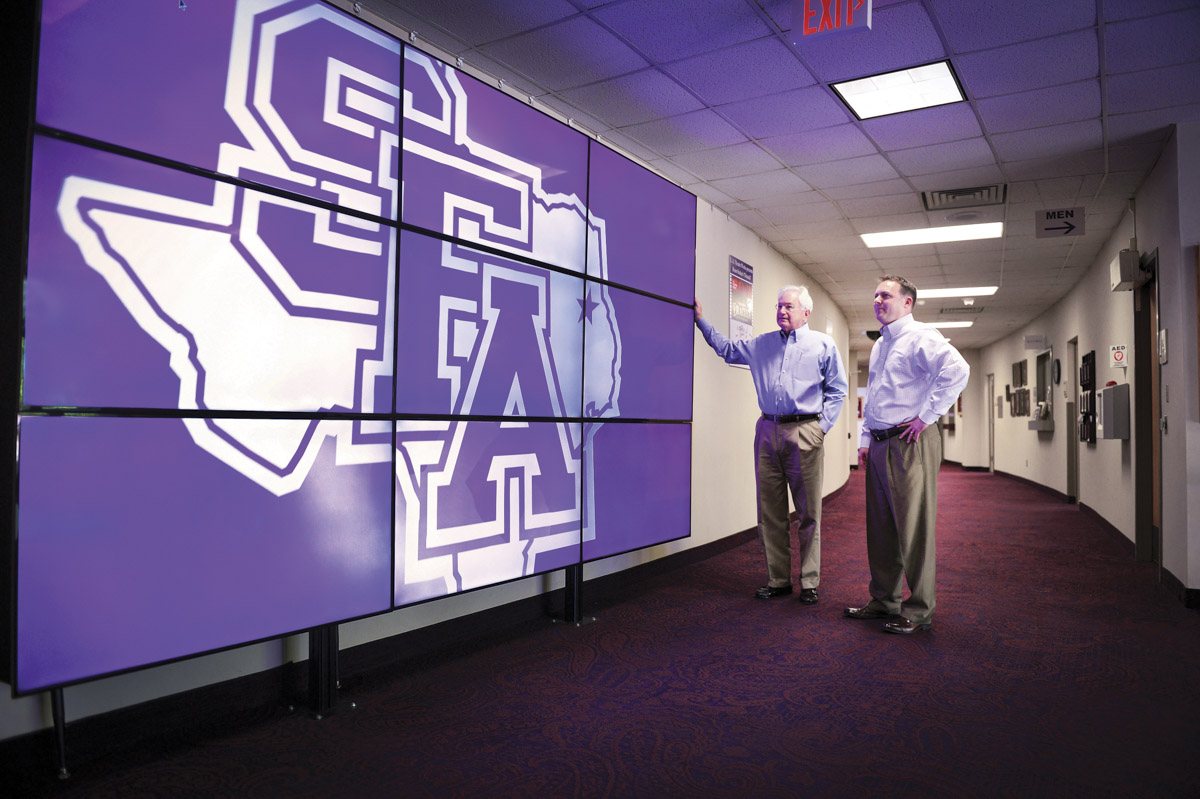What started as staff meeting discussions about how to attract larger audiences to the SFA College of Fine Arts’ University Series eventually evolved into a project that has put the college in the forefront of campus digital signage.
The new larger-than-life video wall array in the lobby of the Griffith Fine Arts Building is wowing audiences of W.M. Turner Auditorium. But more than that, it is a visual testament to innovative SFA employees working across campus departmental lines toward a common goal. It is an example of what can happen when vision meets teamwork.
The College of Fine Arts contributes to the mission of SFA in many ways, according to Dr. A.C. “Buddy” Himes, dean.
“These contributions relate to projecting a refined, artistic, progressive and positive image of SFA to the community,” Himes said. “I’m always looking for new and better ways of doing this, from the quality of programs to the public service announcements we run on local television stations.”
So, when college staff members Dr. Alan Scott, Web developer, and Steve Bacarisse, Turner Auditorium technical director, came up with the idea for a large digital signage array incorporating multiple screens in the Griffith lobby, Himes immediately started looking for funding to bring the idea to reality.
“As it turned out, once the initiative was revealed, everyone who realized what we were trying to do was awestruck with the visual impact of the array and its potential,” Himes said.
In particular, Trey Turner, executive director of development for SFA, became one of the biggest advocates and took on the task of helping find donors to convert the original two-by-two screen configuration into a much larger three-by-three display.
“After hearing about this digital signage array and learning how it would impact students and patrons of the College of Fine Arts, I knew I could find SFA alumni who would be eager to fund an impactful project of this magnitude,” Turner said. “We are grateful for the generous contributions that made this array possible, as they demonstrate how alumni donations add prestige and excellence to SFA.”
In developing the video wall, Bacarisse and Scott researched and experimented with a number of hardware and software solutions for digital signage, particularly in the video-wall realm. Because project decisions were closely tied to cost constraints, they took a “practical but uncompromising” approach to hardware, Scott explained, and hands-on testing allowed the designers to maximize their budget and provide high performance.
The software that drives the signage system was created in-house, allowing the ability to integrate emerging technologies and other resources the college manages, as well as to continue development without vendor restrictions or lock-in.
“This kind of flexibility allows the project to be customizable,” Scott said. “We can be extremely granular in how we display and interact with content on the screen.”
The project aligns with the “academic spirit” of the SFA campus, Scott explained.
“Offering a richer experience for students and patrons has always been paramount to the project, and creating an end product capable of the impact we hoped to achieve required taking on new technologies and frameworks,” he said. “In this sense, there were a lot of risks taken during development that sometimes seemed to be points of failure. Those bumps led to many discussions that, through research and experimentation, evolved into the solutions we needed.”
One of the most enjoyable aspects of the project was the collaborative nature of those involved, Scott said. From Himes and Turner working to secure financial sponsorship, to college staffer Lisa Rodrigues managing the administrative transactions for purchases, to Stephen Rasmussen and Tom Turner in the Office of Telecommunications making sure the right networking solutions were in place, teamwork was crucial to success.
Within the college, Bacarisse’s technical experience was critical to installation, and he and Scott worked closely from concept to completion.
“Alan and Steve deserve most of the credit for the innovative idea,” Himes said. “My role was merely to provide a supportive and facilitative culture for their innovation. And, of course, the project would have just been the two-by-two without Trey Turner’s engagement and support.”
In terms of impact, the digital signage array is so new its potential is still being determined.
“But everyone has been fascinated by it,” Himes said. “It completely changes the way in which Turner Auditorium is perceived by the public and the way in which productions and events function in the auditorium.
“Moreover, we have not even come close to envisaging all the ways in which the digital signage array may by used,” he said. “Filmmaking students are already wanting to utilize it for projects, both as a medium to display their work and as a tool in creating new work.”
As a result of the original project’s evolution into a much larger digital signage array, the smaller two-by-two design was moved to The Cole Art Center @ The Old Opera House where local residents and downtown visitors can view information about the lineup of the College of Fine Arts’ events in a far-reaching, innovative and progressive format.


